|
|
MODERN UNITED STATES MINTS
|
When the United States government began minting coins in 1792, the original Mint facility in Philadelphia was hard-pressed to produce enough currency for our small country.
As the country grew and the demand for coins increased, it became necessary to expand Mint facilities. This expansion was further fueled by the discovery of gold, first in the Southeast and later in the West, and by the need for hard currency which caused people to mint their own gold coins. In the mid-nineteenth century, additional mints were opened in Charlotte, NC; Dahlonega, GA; New Orleans, LA; and San Francisco, CA. In 1870, the Carson City, NV Mint opened, and in 1904 the Denver, CO Assay Office became a Mint facility. Today, in order to keep our economy flowing smoothly, the U.S. Mint maintains facilities in Philadelphia, Denver, San Francisco, and West Point, and a bullion depository in Fort Knox, KY.
The number of coins minted today is astounding. Denver and Philadelphia alone produce 65 to 80 million coins a day. The stories behind each of the Mint facilities are fascinating, too.
Philadelphia Mint Facility
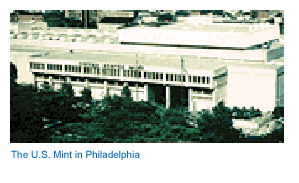
The nation's first Mint provides a wide array of coins and manufacturing services. Like the Denver facility, Philadelphia makes circulating coins of all denominations, commemorative coins as authorized by Congress, and produces the dies for stamping coins and medals. Philadelphia manufactures the "P" mint mark portion of the uncirculated coin sets. In addition, Philadelphia is currently the only Mint facility that engraves the designs of the U.S. coins and medals.
Historical Background: Half Cents and $5 Pieces
Every nation requires its own readily accepted currency. So, in 1792, Congress called for the establishment of a national Mint. Because Philadelphia was then the nation's capital, it was built there. Congress' next decision concerned the money itself. They decided that American coins be made of gold, silver and copper, with $10, $5,$2.50, half dime and half cent pieces, in addition to the coin denominations we have now. Unlike today's five-cent pieces, the half dimes were made of silver.
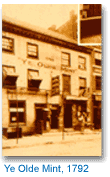
The first Mint was erected at 7th and Arch Streets and by March, 1793, it delivered its first circulating coins: 11,178 copper cents. Their production was overseen by David Rittenhouse, a leading American scientist and the first Director of the Mint.
As the United States and its economy grew, the nation required more coins and larger Mint facilities. The Mint expanded accordingly and moved three times. Its current facility, Philadelphia's fourth, opened in 1969.
Denver Mint Facility
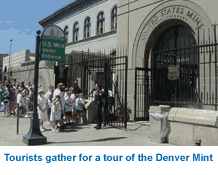 In 1858, when gold was discovered in Colorado, hundreds of merchants, miners and settlers moved in
for their stake. A year later, the city of Denver was founded; and in 1863, the U.S. government
established a Mint facility there. Today, the Denver Mint manufactures all denominations of
circulating coins, coin dies, the Denver "D" portion of the annual uncirculated coin sets and
commemorative coins authorized by the U. S. Congress. It also stores gold and silver bullion.
In 1858, when gold was discovered in Colorado, hundreds of merchants, miners and settlers moved in
for their stake. A year later, the city of Denver was founded; and in 1863, the U.S. government
established a Mint facility there. Today, the Denver Mint manufactures all denominations of
circulating coins, coin dies, the Denver "D" portion of the annual uncirculated coin sets and
commemorative coins authorized by the U. S. Congress. It also stores gold and silver bullion.
Historical Background: Assay Office to Renaissance Palace
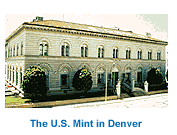 For its first 46 years, the Denver Mint was only an assay office in the Clark, Gruber and Company
Bank Building. Miners brought in gold dust and nuggets to be melted, assayed and cast into bars
stamped with their weight and quality. By 1895, the Assay Office was booming, bringing in more
than $5.6 million in gold and silver deposits annually.
For its first 46 years, the Denver Mint was only an assay office in the Clark, Gruber and Company
Bank Building. Miners brought in gold dust and nuggets to be melted, assayed and cast into bars
stamped with their weight and quality. By 1895, the Assay Office was booming, bringing in more
than $5.6 million in gold and silver deposits annually.
In 1904, the government decided to convert the Assay Office into a working Mint, and built a much grander facility, an Italian Renaissance style building modeled after a Florentine palace. In 1906, its first year in operation, the new Mint produced 167,371,035 gold and silver coins valued at $27 million. Today, the Denver Mint's output can exceed 50 million coins a day.
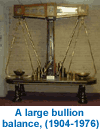 Denver treasures its historic Mint building, which is one of Colorado's oldest institutions.
Denver treasures its historic Mint building, which is one of Colorado's oldest institutions.
San Francisco Mint Facility
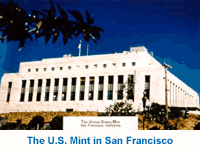 The San Francisco Mint plays an important role in our nation's coinage. Although it does not
currently produce circulating coins, it is the exclusive manufacturer of regular proof and silver
proof coin sets that set the standard for numismatic excellence with their brilliant artistry,
fine craftsmanship and enduring quality.
The San Francisco Mint plays an important role in our nation's coinage. Although it does not
currently produce circulating coins, it is the exclusive manufacturer of regular proof and silver
proof coin sets that set the standard for numismatic excellence with their brilliant artistry,
fine craftsmanship and enduring quality.
Historical Background: The Gold Rush and Great Earthquake
With the California Gold Rush underway in 1849, the U.S. Mint was overwhelmed with the task of turning all that gold into coins. What's more, transporting it all to Philadelphia for coining was both time-consuming and hazardous. So in 1850, President Millard Fillmore recommended that a branch of the Mint be established in California. Congress approved the plan in 1852, and the San Francisco Mint was born.
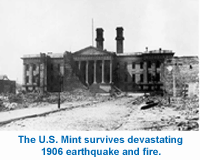 In 1854, the San Francisco Mint opened its doors and began converting miners' gold into coins,
producing $4,084,207 in gold pieces by December of that first year alone.The new Mint soon outgrew
the small brick building in which it was housed. In 1874 it moved to an imposing new facility,
with walls of stone, resembling an ancient Greek temple.
In 1854, the San Francisco Mint opened its doors and began converting miners' gold into coins,
producing $4,084,207 in gold pieces by December of that first year alone.The new Mint soon outgrew
the small brick building in which it was housed. In 1874 it moved to an imposing new facility,
with walls of stone, resembling an ancient Greek temple.
The Mint's production of coins was uninterrupted for 32 years, until the disastrous earthquake of 1906. Because the gas works were partially destroyed, operations stopped temporarily. But the beautiful, solidly constructed Mint building survived both the earthquake and the ensuing firestorm. In fact, the Mint was the only financial institution capable of operating immediately after the disaster and became the treasury for disaster relief funds, performing other emergency banking services as well. Coining operations resumed soon afterward and continued in this building until 1937, when Mint workers moved to a larger, more modern facility, the present San Francisco Mint.
West Point Mint Facility
Located near the U.S. Military Academy in New York state, the West Point Mint manufactures the entire family of American Eagle proof and uncirculated coins in gold, silver, and platinum. The gold and platinum coins are manufactured in denominations of one-ounce, half-ounce, quarter-ounce and tenth -ounce. Silver bullion coins are manufactured in one-ounce denomination.
Historical Background: The 'Fort Knox of Silver' and the Newest Mint
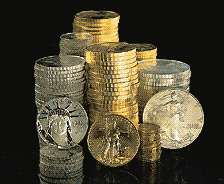 |
| The West Point Mint produces gold, silver and platinum bullion coins. |
Erected in 1937 as the West Point Bullion Depository, this was originally a storage facility for silver bullion and was nicknamed "The Fort Knox of Silver." From 1973 to 1986, West Point produced cents, and in 1980 began striking gold medallions. Shortly afterward, approximately 20 billion dollars worth of gold was stored in its vaults, making it second only to Fort Knox for gold storage. Today, it is also the major producer of gold coins.
The red letter date for West Point was

